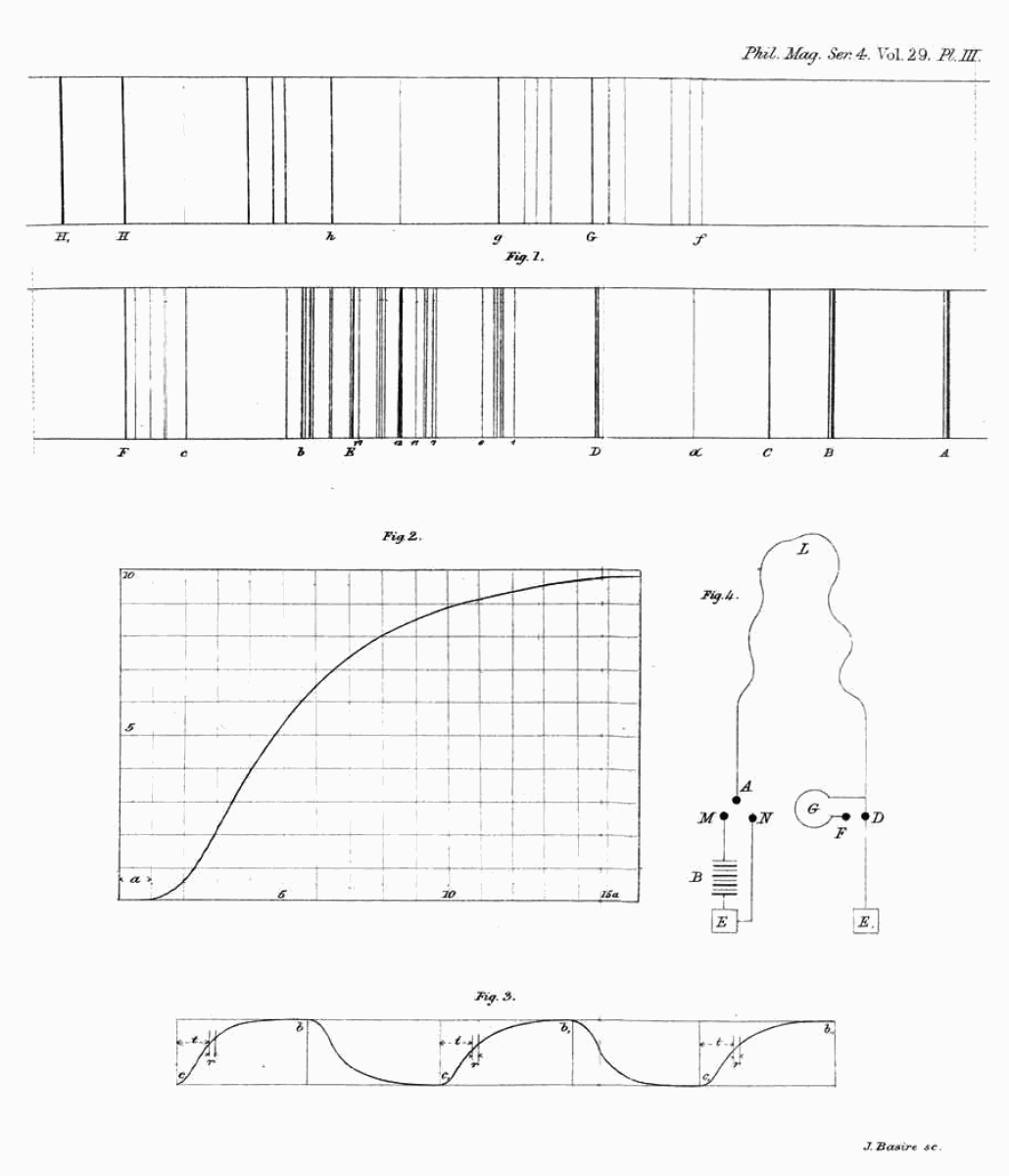

500 On the Translatory Motion of the Solar System. the earth’s annual motion is equal to
A cos &, = A j cos D, sin P sin [© — — sin Dj cosP£, where
— sin Dj = sin 23° 38' cos ©.
In this formula © denotes the right ascension of the sun, P and the same magnitudes as before, and h — 20,,-4 the velocity of the earth expressed by the angle it subtends at the centre of a circle whose radius is the velocity of light. The total correction of the angle <£, therefore, will be
A</>=24,/-9 [cos il + ?i cos b],
since
X.=nh and 40"-8 tan © =24"-9.
If by means of this last formula, and under different assumptions for the value of n, we calculate the correction for each angle <p in Table III., and afterwards add these corrections to their respective angles, the resulting values of <fc + A<j>, subtracted from the assumed true value of 2©4, that is to say, from
<£0=62° 55' 41", will give the following:
Table IY.
|
1 o |
0o — | |||
|
71 = 0. |
»=i- |
»=&. |
n=l. | |
|
II |
It |
// | ||
|
+ 3 |
+ 3 |
+ 4 |
+ 4 |
+ 7 |
|
-11 |
+ 9 |
+ 5 |
+ 3 |
- 2 |
|
-26 |
- 3 |
- 6 |
- 7 |
-13 |
|
-19 |
+ 2 |
- 1 |
- 3 |
- 9 |
|
-10 |
-17 |
-14 |
-12 |
- 8 |
|
-18 |
- 7 |
-10 |
-10 |
-12 |
|
-26 |
- 5 |
-10 |
-10 |
-16 |
The sums of the squares of the differences are respectively 2267, 462, 419,427, 719.
So far as we can conclude from the above observations, the influence of the earth’s annual motion appears to be verified; that of the motion of the solar system is less perceptible. Nevertheless it is obvious that if we were to assume that motion to be zero, or to be equal to that of the earth in its orbit, the agreement between the observations would be worse than under the assumption that the magnitude of the motion in question is
somewhat more than one-third of that of the earth. Between this result, and what we already know of the motion of the solar system through astronomy, there is no great divergence.
I hope during the present year, however, to be able to continue my spectrum-experiments, and to have a better opportunity of determining, numerically, the magnitude of the motion of the solar system. In the present paper my object has merely been to show the possibility of solving, optically, this interesting problem in physical astronomy.
LXVIII. On the Intersections of a Pencil of four Lines by a Pencil of two Lines. By Professor Cayley, F.K.S.*
pLUCKElt has considered (“ Analytisch-geometrische Apho--*■ ristnen,” Crelle, vol. xi. (1834) pp. 26-32) the theory of the eight points which are the intersections of a pencil of four lines by any two lines, or say the intersections of a pencil oifour lines by a pencil of two lines: viz., the eight points may be connected two together by twelve new lines; the twelve lines meet two together in forty-two new points; and of these, six lie on a line through the centre of the two-line pencil, twelve lie four together on three lines through the centre of the four-line pencil, and twenty-four lie two together on twelve lines, also through the centre of the four-line pencil.
The first and third of these theorems, viz. (1) that the six points lie on a line through the centre of the two-line pencil, and (3) that the twenty-four points lie two together on twelve lines through the centre of the four-line pencil, belong to the more simple theory of the intersections of a pencil of three lines by a pencil of two lines; the second theorem, viz. (2) the twelve points lie four together on three lines through the centre of the four-line pencil, is the only one which properly belongs to the theory of the intersections of a pencil of four lines by a pencil of two lines. The theorem in question (proved analytically by Pliicker) may be proved geometrically by means of two fundamental theorems of the geometry of position : these are the theorem of two triangles in perspective, and Pascal’s theorem for a line-pair. I proceed to show how this is.
Consider a pencil of two lines meeting a pencil of four lines in the eight points [a, b, c, d), {a!, b', c', d'); so that the two lines are abed, a’Vdd1 meeting suppose in Q; and the four lines are aa!, bb1, cd, dd! meeting suppose in P; then the twelve points are
* Communicated by the Author.